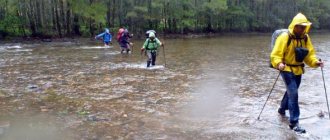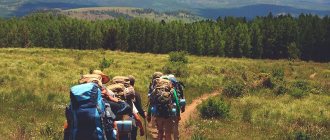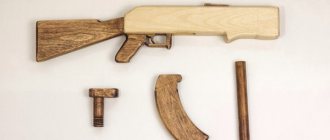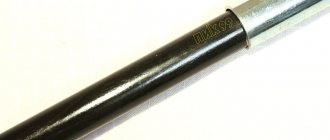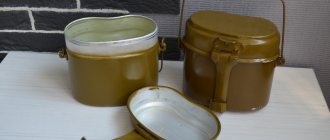Main
Shoes are the most important element of equipment; it is permissible to treat them mediocrely only for the first simple outings. If your friends invite you to go on a weekend hike, you can put on your favorite sneakers, and maybe you will be lucky and you will feel all the pain and suffering from bad shoes the first time. And if not, then you will go on a more difficult hike with confidence that you don’t need to wear anything special on your feet, remembering the previous sunny hike along the paths of some national park. And now, even in difficult conditions, serious problems can appear, and feet rubbed into blood is nonsense. The fact is that while hiking, your shoes are like a car during a road trip: the more reliable it is, the less likely it is to break down, which could lead to a stoppage or, in the worst case, an accident. It’s the same with shoes, the main thing is to realize this before the hike, and not in the middle of the route, in a deep forest or on a high mountain.
Berts?
For a weekend , you can also try using high-top boots. In any case, the shoes should be comfortable and fit well on thick knit socks (such as trekking socks). When descending, your toes should not rest on your boot, otherwise you will get blisters.
The ankle must be fixed, the toe must be protected with thick leather or a plastic insert. The sole must have good grip and be wear-resistant. It is desirable that shoes have good vapor permeability and water-repellent properties.
Just like trekking boots, ankle boots have a tough, wear-resistant sole. The ankle is fixed. They have a protected toe cap. However, they have a number of significant disadvantages:
- inferior to trekking boots in terms of sole and tread quality
- often unreasonably heavier than trekking boots
- get wet quickly
- takes a very long time to dry
- don't breathe well
- after drying, the skin tightens and decreases in size
- even well-worn ankle boots rub your feet during long treks under load in trekking socks
The only advantage is the price, which is 2-3 times less than trekking boots.
As an example, for comparison, we present the model of ankle boots that was used before purchasing trekking boots: England II.
How are hiking shoes different from city shoes?
“I wore exactly the same sneakers for 5 years!” - stated my upset friend on the second day of the hike, looking at the sole that had completely peeled off from both sneakers at once.
Let's not blame city shoes for poor quality, especially since this is not the case. What is intended for the city can walk the streets for years. On a hike, a whole series of additional loads appear that ordinary sneakers cannot withstand. Multidirectional loads on descents and ascents, regular contacts with tree roots and sharp stones, a lot of water and moisture, and on top of that, 10-15 kilograms of additional backpack weight. Accordingly, when designing shoes for tourism, various methods are used to counter these destructive factors. These include reinforced seams using durable threads, and fundamentally different materials, including shoe glue, and most importantly, thoughtful design reliability, whereas design is always a priority for city shoes. Hiking shoes are tougher, stronger and much more comfortable (we are talking about use on a hike).
Specialized shoes
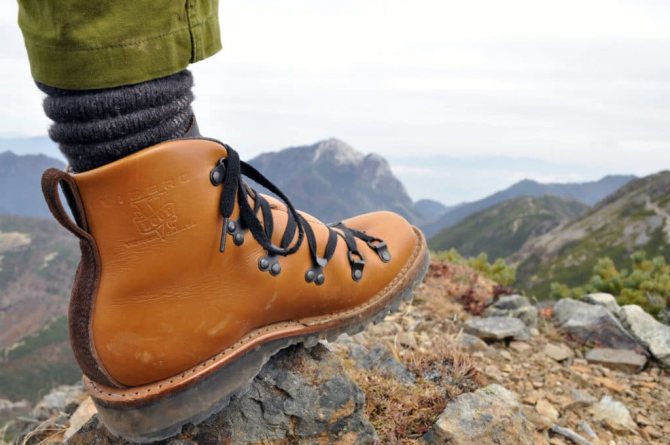
Since modern wild tourism takes more than a variety of forms, specialized shoes come in a wide variety. For example, there are shoes for hiking in places associated with constant contact with water. Rafting on mountain rivers or routes involving crossing a large number of rivers.
Such shoes definitely do not have a membrane, dry easily, but do not accumulate water. These shoes can be complemented with neoprene socks, which provide your feet with comfort even in conditions of constant humidity.
Another point is the special sole that does not slip on wet stones.
Another type of specialized footwear is rock shoes or simply rock shoes. They have a thin enough sole for the foot to feel all the features of the terrain. In addition, the sole of such shoes is made of a special material that provides the most durable grip on the stones.
Types of shoes for tourism
There are no shoes in which you will feel equally comfortable in fundamentally different conditions, so before purchasing you need to decide where and how you will use them.
Gear is not mathematics, so there is no single formula by which hiking shoes are classified. Moreover, brands, competing in the ingenuity of advertising moves, often introduce new types and subtypes, completely intertwining the already confusing terminology. We won’t complicate things, but simply build a chain of expected conditions of use from simple to complex.
Quite simply, no obstacles, no terrain, no backpack.
This applies to urban tourism and simple travel. Yes, such shoes also exist, and they are much more comfortable than fashionable city shoes. In the summer - these are sandals, open sneakers or light sneakers with mesh, and for cold times - insulated sneakers and boots. Unlike ordinary city shoes, specialized ones have a comfortable anatomical sole and much more wear-resistant materials (we will talk more about technologies and materials below). Among manufacturers, terms such as Life style or City style shoes are often used, and often they look no worse than fashionable sneakers from famous brands.

Simple, but possible obstacles, unpaved paths, light backpack.
This is where a little protection comes in handy. For example, there are sandals with a closed, impact-resistant toe that will protect your toes from damage. A simple lightweight mesh on sneakers can be torn by tree roots or bushes, so you need to look towards more durable materials for the upper of the shoe. Western manufacturers often call such shoes hiking (hiking), and sometimes even shoes for light trekking.

Difficult, sloping terrain, difficult trails, many obstacles, noticeable weight of the backpack.
As soon as the expected conditions include terrain, elevation changes, or, more simply put, when you are going to go to the mountains, you will need additional protection, in addition, the weight of the backpack begins to put serious stress on the ankle. First of all, it is important to fix the leg, preventing dislocations and sprains. Medium-height hiking and trekking boots can handle this. Often in foreign names you can see the word middle or mid, which actually means medium in height. Plus, the high height combined with moisture-resistant materials help keep your feet from getting wet. Accordingly, the requirements for wear resistance of such boots increase significantly. Here you can choose light and soft (relative to more specialized mountain boots) trekking boots.
In some cases, you can choose rigid high mountain boots, in which you will be even more reliably protected, but due to the additional weight and greater leg fixation, you will get more tired on areas with good trails. In this regard, I repeat once again, think carefully about where and how you will use your shoes.

For example, to hike to the foot of Belukha (the highest mountain in Altai), heavy boots are not required: since the route is very popular and follows a well-trodden path, light trekking boots of medium height will be sufficient. At the same time, to climb Belukha, you need a serious, hard boot with the ability to attach crampons. In this case, you can walk to the bottom in light sneakers, and wear a specialized boot for the climb. Of course, carrying an extra pair of shoes is not easy, but sometimes it is the best option. And if you start doing this professionally or at least regularly, your ankle will be more trained and will allow you to use light and soft trekking boots more often.
Very difficult – sports and extreme climbing
The main rule here is reliable protection of the legs from any damage and weather conditions, regardless of weight and even comfort. Starting from simple mountain boots, which have increased rigidity, to high-tech multi-component boots for mountaineering, all this is professional equipment that needs to be analyzed in much more detail, which is beyond the scope of this article.

If you suddenly decide to go on a difficult category hike, first of all, consult with the route leader about what kind of shoes you should use. If you are a leader, but for some reason you are reading an article for beginners, then I ask you, do not put the lives of the participants in such danger , find an experienced guide!
Not just walking.
Running shoes are a separate topic for this article, and despite the fact that they are also intended for active use, it is better not to use them when hiking. I especially don't recommend using widely advertised fitness sneakers that destabilize your feet - they may actually stimulate your muscles to develop, but destabilization at the moment when you climb a mountain can be dangerous, to put it mildly. Remember the simplest rule - use shoes for their intended purpose: if you're going to a race, yes, take running shoes, if you're going on a hike, take hiking shoes.
There are also a number of specialized models for outdoor enthusiasts. For example, during rafting, you will need special sandals that slip less on wet rocks, dry faster and do not accumulate water inside. Climbing requires rock shoes, yachting requires non-slip boots, and cycling has contact and non-contact boots. In addition, there are non-standard options such as five fingers from vibram, their concept involves preserving the natural sensations of walking and playing sports, while relatively protecting the foot from damage.

Criteria for choosing trekking boots
Choosing shoes for tourism is a responsible matter. The degree of comfort during travel and human health depend on it: boots protect feet from impacts, dislocations, sprains, and rubbing calluses.
Therefore, when choosing, you should pay attention to several points.
Tracking type
According to complexity they are distinguished:
- hiking (walks outside the city in favorable weather);
- light trekking (short hikes without load);
- medium (long trips with load);
- heavy (multi-day hikes in hard-to-reach places, usually in the mountains);
- mountaineering (mountain ascents with elements of rock climbing in extreme weather conditions).
The general rule for this criterion is that the more difficult the route is, the higher the boots should be, made of more rigid materials. This will improve grip on the surface, reduce the load, and securely fix the ankle, minimizing the risk of injury.
There are trekking sneakers, hiking, mountain, and mountaineering boots.
Trekking sneakers are suitable for hiking when the route runs along ready-made trails. The main differences are lightness (on average one pair weighs 500 g) and low price. Suitable for lovers of walking on flat terrain and a sporty style of clothing. It is not recommended to wear when hiking in the mountains and rough terrain due to poor ankle support, because the sneakers are short and the sole is not too rigid.
Hiking boots made of leather are suitable for such hikes. They are high, fit tightly to the leg, keeping them from dangling. Outsoles with a special large texture prevent slipping on any type of soil, including dirt, stones, and wet grass.
Boots are much more powerful than sneakers (a pair weighs up to one kilogram), which is a safety requirement when moving over rough terrain. At the same time, with a plastic sole, so that you can more freely feel the terrain under your feet and not get too tired on long hikes.
Mountain boots are designed for climbing and heavy trekking, combining mixed terrain, scree slopes, steep climbs, and glacier crossings. Equipped with rubberized welts, convenient for crampon fastenings. They have a rigid outsole with aggressive grip, a water-repellent treatment or membrane, usually Gore-Tex, a plastic heel shock absorber and a midsole.
The pair weighs about one and a half kilograms, which helps absorb shock loads. They are mainly made of waterproof nubuck in combination with textile inserts.
Mountaineering boots are the most difficult trekking shoes:
- with additional insulation;
- with lugs for movement in low temperatures, on ice;
- with a membrane for vapor permeability and water drainage.
These are multilayer structures. The inside has a removable neoprene liner with laces, and the outside is durable plastic. Between them is a layer of warm air. Many models are equipped with protective gaiters. It is important for climbers not to overcool their feet.
Despite the impressive weight (one pair pulls from one and a half to three kilograms), there is no feeling of heaviness in the legs. The lining is sewn from three to four layers of heat-insulating materials. Unlike other types of hiking shoes, mountaineering shoes have a carbon inner sole.
Plastic boots are a budget option: inexpensive, but warm and durable. Their disadvantages are the lack of a ventilation system and the last is too hard, which causes your feet to sweat and get tired faster. Due to the soft top, these shortcomings are somewhat smoothed out.
In general, mountaineering shoes are very heavy, rigid, overly durable and expensive, and are unlikely to be useful for travel other than high-altitude climbing and industrial mountaineering.
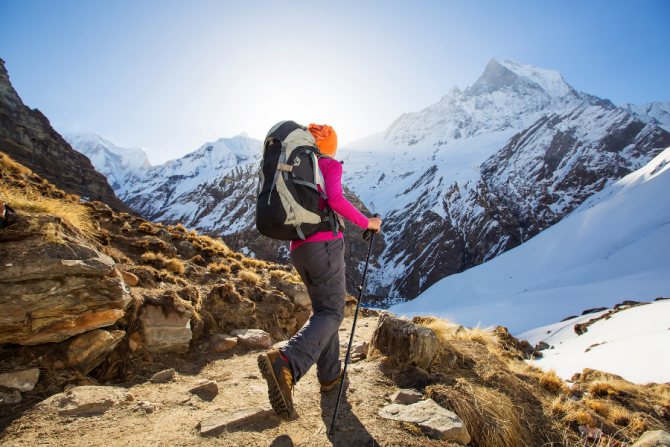
Season
It is important to consider for what time of year and climate zone trekking boots are purchased. They are summer, winter and demi-season.
Summer boots are more similar in height and design to sneakers. They are lightweight, with a powerful but soft sole, made of textiles with a reinforced rubberized toe. A very good ventilation system due to the use of membrane technology allows the feet to breathe even on the hottest days. Membrane fabrics allow moisture to pass through only in one direction - from the inside. Therefore, summer boots are very comfortable.
Winter models have special requirements. In addition to excellent grip, secure foot retention and water-repellent materials, it is important to maintain a comfortable temperature for your feet even in severe frosts. For this purpose, high-tech synthetic materials that have the effect of a thermos are used. Therefore, winter boots are massive, with thick leather. It is important that in winter shoes there is a small gap between the toes and the toe, about a centimeter, to prevent hypothermia. Winter trekking involves moving on slippery ice, which means you need welts to install crampons.
Demi-season hiking shoes are intended and developed for use in the off-season: in conditions of high humidity, wet snow, mud, as well as differences in night and day temperatures. Therefore, the outsole uses durable Vibram rubber with excellent grip on no matter how wet the ground.
This model range provides shin fixation due to the increased height of the boot. A rubberized edge around the perimeter protects against moisture, just like the Gore-Tex membrane fabric.
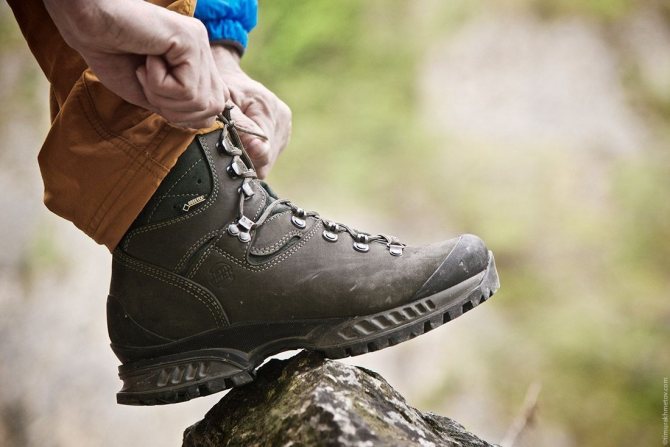
Floor
Depending on the gender, the following types of boots are distinguished:
- unisex;
- women's;
- men's
Unisex models are presented mainly for hiking, light and medium trekking. These models are offered in neutral colors: brown, beige, gray, blue. The size range is also varied.
Women's models can be found among trekking sneakers and boots for light trekking. The developers focus on the anatomical features of the female leg. Therefore, women's boots look more elegant, with a narrowed shaft and a high instep. The color range of women's boots is varied: pastel, delicate, bright colors, as well as combinations of several shades.
Male models are the most common. These are brutal, massive shoes. Among mountain and mountaineering boots, only models for men are presented, since these are far from women’s sports.
And in terms of weight, these are the heaviest of trekking boots; a lady simply cannot carry three-kilogram shoes. The main colors of men's boots are dark blue, brown, black.
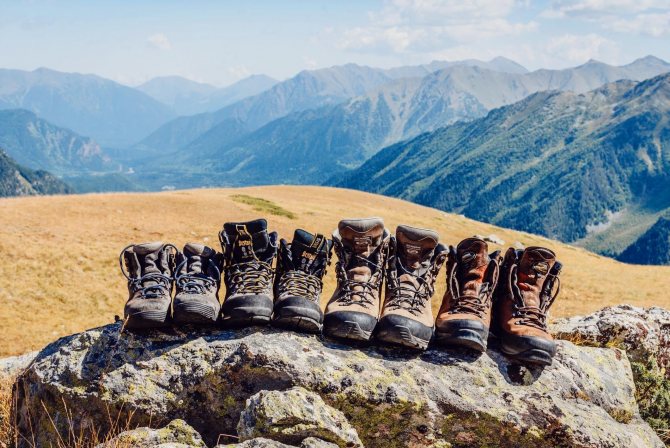
Anatomy of a hiking boot or “Why are trekking shoes so expensive?”
External material
The task of the outer layer is to withstand the environment, to be sufficiently wear-resistant, but at the same time light, at the same time not to allow water to pass through from the outside and to remove moisture from the inside. All these are not easy tasks, and developers are constantly refining their models, which inevitably affects the final price.
I already wrote in detail about materials in another article; this knowledge also applies to shoes. It is worth adding that shoes are still often made from genuine leather or nubuck (treated leather), as this material is truly durable. But in our time, synthetic materials are no worse, and sometimes even more effective, in resisting nature. In addition, synthetics are much lighter than leather and dry faster after being completely wet. It is believed that the fewer individual parts in the material of the upper of the boots, the more reliable it is, since first of all the shoes are worn at the seams. However, this should not be a decisive factor when choosing trekking shoes, since the seams in quality shoes are made securely and in the right places, and the final cost is often cheaper than one-piece models.
The use of a membrane in shoes is justified, however, the care of shoes must be appropriate. You should not have any illusions about the absolute waterproofness of the membrane, as well as about its ultra-high breathability. If you are interested in how a membrane works, I recommend reading the corresponding article. And here I would like to note that the use of a membrane in trekking shoes has increased the comfort of hiking significantly, and this is a fact. If you want to argue and say that leather is cooler, then I will even agree, but leather is a kind of natural membrane, it also does not allow drops of water to pass through, but allows steam to pass through; But the skin gradually absorbs moisture, and drying it quickly without consequences is extremely difficult. And of course, both the membrane and the skin come to the aid of special impregnations that help repel moisture, and these impregnations must be periodically restored.

Sole
Perhaps the most complex and important element of any hiking shoe is its sole. The purpose of the sole is to resist twisting in all directions, soften shock loads, insulate heat, protect against sharp objects and behave reliably on various surfaces, providing clear traction. Each task in good boots is solved by different layers, and the sole in this case consists of a whole sandwich of different materials.
Most often you will find a vibram badge on the sole in stores, but this is only part of the sole - the outsole, made of specially durable rubber. Vibram is a brand that produces many different soles and more (five fingers shoes, for example). Of course, using vibram is good, but manufacturers do not always use it correctly, and counterfeits have been around for a long time. You can protect yourself from copies only by buying goods in good stores that you trust.
In addition to the bottom layer in contact with surfaces, the sole may consist of a torsion element, a vibration-damping layer, a heel support, reinforcing struts and other elements. Manufacturers pay special attention to the sole, and over the years hundreds of types of designs have been invented using completely different materials. Are they necessary? Certainly! All these elements are designed to protect your legs, not only your feet, but also, for example, your knees (the vibration-absorbing layer reduces shock loads), ultimately preserving your health.

Insole
An essential part of good trekking shoes. High-quality insoles have additional insoles and supports against pronation, as well as additional heel vibration dampers and a breathable base. The presence of antibacterial treatment is also important, since in camping conditions and traveling there is no opportunity to often change socks and wash shoes. For particularly cold hikes, as well as for people with problems with blood vessels, there are insoles with electric heating.
However, the insole is a problematic area of the shoe, but not through the fault of the manufacturers. Each person's foot is unique, so it is simply impossible to produce insoles that suit everyone. Fortunately, the insoles can be changed and purchased separately, and in special cases it is possible to manufacture special orthopedic insoles to order, but this is quite expensive.

Other
For lacing, serious models use metal loops, which are more reliable than textile and lurex ones; in addition, they provide easier and faster tightening of the laces. Synthetic insulation is added to winter options. Boots designed for heavy conditions may have an entirely rubberized bottom, and older models add a raised welt for attaching ice climbing crampons. Shoes for climbing have a complex multi-component design made of a warm inner felt boot and a hard plastic outer layer, somewhat reminiscent of a ski boot. Different models may have additional structural elements, but I will not dwell on each of them, since there will be separate articles about professional and specialized options. Subscribe to the email newsletter, you might be interested.
How to choose ankle boots?
Such a long-awaited summer is already outside the window, and of course many of us are thinking that it wouldn’t be a bad idea to go camping. The matter is of course extremely interesting, but you need to be 100% prepared for it. We have already written about what you can, and maybe even need to, take with you on a hike.
- Boots with high tops Butex "KALAHARI" model 1411
RUB 3,650Buy
- Boots with high tops Butex "MONGUST" leather model 24111
RUR 4,190
Buy
- Boots with high tops Butex "Mongoose URBAN" model 5005
RUB 3,990
Buy
- High-top boots Alloy “Fighter” model 03006
4,000 rub.
Buy
- High-top boots Largos “Tactic” model 381
2,300 rub.
Buy
But we left such an important issue as the choice of trekking shoes practically without attention. As we have already said, all shoes can be divided into 3 types:
- Heavy
- Average
- Lightweight
And if the first two are a dark forest, an area of high matters and incredible taste, then we can talk to you quite a lot about easy tracking. Light trekking is where such wonderful shoes as combat boots come into play, and this article is about how to choose them.
Many “experts” argue about whether combat boots are suitable as hiking boots, since these boots were originally designed for the military, and often do not have many of the bells and whistles that have become common in any trekking shoe. Naturally, we will not talk about the fact that ankle boots are an ideal option for a hike, but despite a number of disadvantages, they also have many advantages.
- Simplicity of design
- Price
- Strength
- Large size chart
We will talk about each of them in order. The first and most important thing is, of course, the simplicity of the design and the simplicity of the materials. Of course, by and large these shoes have not changed much over the past 20-30 years, and even today we can find models similar to those in which our parents went hiking. And this is where the main plus and main minus of these shoes lie.
“For the sake of an example, let’s imagine a situation where you hit your foot in the water and your shoe took a sip of water.”
With ordinary boots everything is very simple. We take off the shoe, pour out the water and just dry them by the fire, which doesn’t take us very much time. If we are talking about serious trekking shoes, then drying the membrane in front of a fire will no longer be possible and you will have to “dance with a tambourine” for quite a long time to dry them.
Plus, the simplicity of the design often guarantees us the durability of the product (I adhere to the logic that the fewer bells and whistles, the fewer chances that they will break). Please note that this is a particularity rather than a rule, and this is my purely personal opinion.
Of course, there is an exception to the first point and sometimes there are ankle boots that are equipped with a membrane and even a special tracking sole, but this, as I already said, is particular.
Price is the second, but no less important aspect, why a tourist chooses ankle boots as hiking shoes. Often, due to the simplicity of materials and design, the price of such shoes starts from 1,500 rubles.
Durability – we have already mentioned in passing that the simplicity of the design, most often, guarantees the strength of the product, but we should not forget that most often ankle boots are
the evolution of military models that have proven their suitability for extreme conditions more than one hundred times.
As an example we can consider
Product availability: In stock
| RUR 4,150 |
or
Buy for 410 rub. on credit
Best price - Why?
Butex “Kalahari” is an evolution of the standard military boots and they are rightfully recognized by tourists as a “kill-proof model”.
Large size chart - here it doesn’t cost much to say. It’s easier to say that we have boots up to size 50 available for purchase.
Materials:
We've sorted out the lyrics and now we can talk about materials and some nuances that you need to know about when choosing.
Upper material:
The first, and in our opinion the main thing, is the upper material. Usually everyone is used to the idea that combat boots are made of leather and there are no other options, but I hasten to tell you that this is not the case. To make shoes lighter, manufacturers use many combinations and the following groups can be distinguished:
- Pure leather boots
- Velor boots
- Boots made of leather with nylon inserts.
- Boots made of velor with inserts made of natural materials.
Boots made of pure leather are, as has already been said, an absolute classic and there’s nothing to even say here. Leather is the most durable material, and it has a number of advantages:
- Strength
- Water resistance
- Adaptation to the foot
But with all these advantages there are also disadvantages. So, for example, a boot made of pure leather will weigh many times more than a combined model. Of course, thermoregulation in the skin is a rather difficult task.
In general, leather ankle boots can be considered for autumn hikes, or when you know that the route involves water obstacles. Then these models will serve you faithfully.
Combined models are a priori lightweight ankle boots. As an example, we can consider Butex “TROPIC” model 716, where the manufacturer uses a combination of their leather and nylon.
Combined top:
- chrome leather (1.4 – 1.6 mm)
- High tenacity 1000D nylon thread fabric
It was thanks to this combination that the weight was reduced to 535 grams. and, at the same time, the boot only slightly lost in water resistance and density.
Next, let's look at models made of velor, which are often difficult to classify as trekking shoes, since velor is much less susceptible to mechanical damage and, of course, water resistance can only be achieved through impregnation. These shoes can be classified more as urban shoes.
The only time we would definitely advise you to buy a velor model is when you know for sure that you will have to use the shoes in a hot climate, since the thermoregulation of such models is much better than that of leather.
Well, in conclusion, a few words can be said about ankle boots with inserts made from natural materials. I won’t talk about the water resistance and durability of such solutions, but such models are perfect for extremely high temperatures.
Sole:
There is not much to say about the material of the sole of the boots, because often vulcanized rubber or artificial rubber is used. Here it is quite difficult to decide which type of sole is better, since manufacturers use not only raw materials of different classes, but also even different production methods. So, for example, ankle boots from the nearest military store for 1500 will most likely have a rubber sole, but the production quality of such models will be at a low level and there is no point in talking about quality characteristics.
Plus, there are quite a lot of different opinions about the type of sole attachment. There are a great variety of fastening methods, but in ankle boots only 3 main types are often used:
- welted-stitched
- adhesive
- injection molding
And here, as in everything related to tourism, there are many discrepancies. Some say that the first fastening method is the best, some say that only the injection molding method is acceptable for tactical and trekking shoes, and we can say that all 3 methods are good when made well. For example, the manufacturer BUTEX mainly uses the adhesive fastening method for its models, and the level of rejection for these boots is almost zero.
Nuances:
Of course, there are a few little things to keep in mind when choosing hiking boots. The first and most important thing is the length of the ankle itself. In Simple Touring Models, the ankle is fixed using the ankle strap. And you should understand that if the route ahead is not easy, then you should not choose the shortened option.
Lacing: lacing in ankle boots is also an important nuance, since the tightness of fixation depends on this. At this point, it’s only worth remembering that the laced boot should sit comfortably, and the tongue should be fully secured in order to avoid water flooding.
Tread. The tread should be chosen as aggressive as possible, but the sole should be soft enough to make the shoes simply comfortable to wear.
And of course, amplifiers in places of greatest load. If you understand that heavy loads await you, then you should choose models with reinforced backs, etc. For example, Butex “Extreme” is equipped with a toe and heel made of reinforced thermoplastic material.
To summarize, I can say that ankle boots are an excellent option for a novice tourist. And among a huge array of models, you will definitely be able to choose the one that will serve you faithfully for more than one year.
Also, do not forget that the durability of the boots depends directly on you and only with proper care can the boots last more than one season.
Hiking shoe brands
In general, there are quite a lot of manufacturers of good shoes, but unfortunately, not all of them can be found on the Russian market. Here I will only list the most famous and most respected companies among my compatriots:
Asolo , Lowa , Scarpa , La Sportiva , Meindl , Dolomite , Zamberlan , Millet , Garmont , Lomer , Keen , Vasque , Salewa ...
This is not a complete list, but rather one that I personally touched. Besides them, we can mention Salomon, which sometimes produces good boots, but for some reason reviews specifically for this company are always contradictory. Also, shoes are often produced by so-called multi-brands, which make all the equipment without specializing specifically in shoes, for example Mammut (Raichle), the American The North Face or the German Jack Wolfskin .
Choosing shoes for a hike in the forest
When choosing equipment for traveling through the taiga, you need to start, perhaps, with the simplest, but at the same time, perhaps, with the most important - with shoes. Until recently, the entire choice of hiking shoes came down to sneakers, rubber boots, hiking or army boots. There is no need to seriously talk about sneakers as shoes for a difficult journey through the taiga.
Rubber boots can serve well on very wet, waterlogged soil. At the same time, the legs in glued boots get less tired, but cast boots are more durable, they are not so afraid of sharp dry branches. But, to be honest, when going on a long taiga journey, a fair part of which will pass through swamps, it is naive to assume that you will be able to avoid getting your feet wet. In any case, geologists, prospectors and other field workers, receiving rubber boots and knowing that they will have to work in swamps, usually immediately pierce these shoes so that the water flows in and out, so to speak, under its own power. If every time you scoop up water, you stop and pour it out of your boots, then there will be no time to work.
More than one generation of tourists sported ordinary tourist or similar high army boots. These are good, durable, largely versatile hiking shoes. Boots taken a size larger allow you to insert a felt insole and wear a thick sock, and high lacing tightly wraps around the ankle. It is necessary that the toe of the boot does not put pressure on the toes. In order to increase the water-repellent properties of the boot and the elasticity of the leather, you need to soak it in a mixture of fifty grams of paraffin and two hundred grams of drying oil heated over low heat, to which you must successively add one hundred grams of rubber glue and one hundred grams of castor oil. It is important, before adding a new ingredient to the warm mass, to thoroughly mix the liquid first, ensuring its homogeneity. In hiking conditions, boots can be lubricated with any unsalted fat. In this case, you first need to heat the boot near the flame of a primus or fire (the main thing is not to overheat it, otherwise the leather will warp), and then apply a thin layer of fat. This procedure must be repeated several times until fat begins to appear from the skin when pressing on it. In the absence of fat, you can improve the waterproofness of your shoes by impregnating them with tar. Tar can be easily obtained from birch bark by placing it in a tightly closed container and heating over low heat until a dark, pungent-smelling liquid forms. This liquid is tar, which is used to lubricate shoes that are dry and slightly warmed by the fire.
Several years ago, so-called trekking shoes appeared on the Russian market, specially designed for travel of varying complexity - from weekend hikes to climbing Everest. Let's leave aside boots for high-mountain and polar expeditions and turn to middle-class shoes, which are perfect for taiga travel.
Good trekking boots are usually made from a single piece of oiled leather or water-repellent nubuck lined with breathable membrane fabrics such as Gore-Tex or Cambrelle , which makes the boots durable, waterproof, ensures dry feet and removes water vapor from the shoe. The outsole texture, made of wear-resistant Vibram rubber, perfectly holds the foot on any surface. The asymmetrical tongue, high cuff and quick lacing/unlacing system of the boot secure the foot well, without constricting the blood vessels and ensuring uniform contact of the foot with the boot.
Shoes for difficult hikes must have an intermediate shock-absorbing sole made of ethyl vinyl acetate, polyurethane, nylon and various shock-absorbing inserts, which protects the foot from excessive shock loads during long treks and reduces the risk of twisting the foot. The reinforced heel and toe protect the foot from impacts, and the anatomical insole, supporting the arch of the foot, reduces foot fatigue. Comfort in these boots is guaranteed. Manufacturers whose product quality is beyond doubt are Salomon, Garmont, Dolomite, La Sportiva, One Sport.
Sometimes you can see trekking sneakers in stores. Most of these shoes are intended for walking and running over rough terrain, recreation and sports in nature, walks in the forest, and not for complex long-term taiga expeditions. Nevertheless, some models (such as Adidas pleva, Eider kwad high ), made using almost the same technologies as trekking boots, look very decent and can probably be used on serious hikes. Whatever your hiking shoes, you should first break them in and only then go on a trip.
It may happen that during a hike the boots become completely unusable or are lost. Then you will have to start making improvised shoes. The simplest sandals can be made from a piece of wood and fabric. To do this, a small piece of fabric, animal skin or tree bark is sewn to a wooden sole using threads, thin branches, and tendons.
More comfortable are soft shoes made of leather or animal skins, made in the manner of those worn by northern peoples and commercial hunters in the east and north of our country - moccasins, ichigas, olochs. These are high ankle boots without soles and heels, made from camus - skins from the legs of elk or other deer.
To remove the camus from a killed animal, circular cuts are made in the upper and lower parts of the joint, and then, tearing the skin off the leg, they pull it through the hoof. After dressing the skin removed in this way, it remains to be tightly sewn up along the lower edge, to make a cut at the top for the leg, along the edges of which to pierce holes for the laces. An additional piece of hide sewn to the bottom of the moccasins can be used as a sole. The insoles in such shoes will be dry grass or moss.
In any weather (unless it is too hot), it is better to use wool socks rather than cotton socks when hiking. The latter very often bunch up into folds, which can easily rub your feet. In rubber or tarpaulin boots, footcloths are wrapped over the sock.
I'm standing in a store, what should I look at?
Clearly define the terms of application for a future purchase
This is the most important step, as soon as you decide this issue, you will be faced with a choice of at best from a dozen pairs (speaking of a large store, in my city there will be at most 2 - 3 options).
After solving the first point, all you have to do is try on all the available options
Definitely everything! Don't think about appearance, this will be the last factor when choosing. Remember: hiking shoes should be as comfortable as possible.
Since the materials of trekking shoes are stronger and stiffer than the materials of everyday city shoes, hiking shoes are much more difficult to break in. That is, over time, it wears in very little, unlike usual city shoes.
Wear both shoes, lace them well, and walk around the store in them. If you feel real discomfort, take it off! If in 15 minutes you feel something is wrong, over many days and kilometers it will multiply many times over! Conversely, if you don't experience any discomfort the first time you use it, the boot will probably suit you well. Never listen to advice about the comfort of certain models; human legs are as different as our faces. What is convenient for one person may be a bucket of nails for another.
Find the right size
You can't take it end-to-end, the standard rule is to completely loosen the laces and, inserting your foot inside, move it forward so that your toes touch the front wall, while your index finger should fit freely between your heel and the back of the boot. This way, when you lace up the boot and the heel is in place, your toes will have plenty of room in front. Failure to comply with this rule can result in calluses and pain in the fingers after long descents. Do not pay attention to the size numbers, take only by feel.
Also pay attention to the width of the last and the sensations in the heel area: it should not dangle freely up and down - this means that the instep of the boot is too high for you, try re-lacing the boot, if the heel still comes off the sole, take the next model.
If you don't already have one, buy a special trekking sock and try it on with it
The special sock has thickenings in areas subject to heavy loads, which reduces the likelihood of chafing. In addition, trekking socks are often better at wicking away moisture. If you plan to use the boot in cold weather, consider that you will have to wear a thick sock, and you need a small amount of reserve inside the boot, which can be compensated for in the summer with a thicker insole.
Hiking shoes
In this article we will talk about what kind of shoes we wear when hiking in the mountains.
In general, you should have three pairs of shoes: a main pair (usually hiking boots), a backup (sneakers, usually lightweight), and flip-flops or sandals (to rest your feet in parking lots). We won’t dwell on flip-flops in detail (I’ll only note that they should be light and take up little space in the backpack), but we’ll look at boots and sneakers in detail below.
Also, when hiking, they sometimes use crocs (for an amateur), combat boots (for a big fan), and occasionally rubber boots (for example, when hiking in Kamchatka).
When going on a hike, it is very important to choose the right shoes - comfortable, with strong, thick enough and non-slip soles, preferably securing the ankle, which will protect the legs from dislocations and sprains. It depends on whether you will admire the mountain landscapes or think about your sore, damaged feet all the time. If for the Crimea normal sneakers paired with trekking sandals are often enough, then for the Caucasus and other “high” mountains, due to frequent rain, sleet and high humidity, shoes must also have water-repellent properties. To go with your boots, buy special hiking socks - thermal socks, which wick sweat away from your feet further into the membrane. You will receive comfortable, shock-absorbing shoes that protect your feet from sprains, specially designed for outdoor activities. You can’t dry membrane boots (or any shoes in general) by a fire - you’ll ruin an expensive item. The membrane in inexpensive models may not “breathe” well and even smell bad, so its presence is not always a plus.
Trekking boots
There are also mountain boots (we are not considering mountaineering boots here) and these are not exactly the same thing, although it is difficult to draw a strict line between mountain boots and trekking boots.
Mountain boots are designed for difficult hikes and mountaineering. Leather, with a Vibram sole (flexible, non-slip rubber - excellent grip, strong and durable), a rubberized strip (as additional protection against getting wet), with a rear welt (at a minimum, but also with a front one, for attaching crampons) and a membrane, such as, for example, GORE-TEX (removes fumes from inside the shoe, does not allow moisture from the outside to pass through - the feet remain dry). Trekking boots (for light hikes) can come without these extras and are usually cheaper.
The more expensive the boots, the better they are. When purchasing, you can consider any well-known brands (Zamberlan, Lowa, La Sportiva, Asolo, Meindl, etc.) - the main thing is that the shoes fit your feet well and do not cause discomfort. You can save a little by using the loyalty program of sports stores and (or) buying at discounts. Ordering from an online store is not an option; you must try on the shoes before purchasing. You need to understand that the size ranges of boots differ from each other and from urban shoes, i.e. if in the city you wear shoes, for example, size 44, then Zamberlan needs at least 45.5 (if not 46). Firstly, the size itself does not match, secondly, you, at least sometimes, will put the boot on a trekking sock, thirdly, you need to put an additional half-size on top, otherwise on the descent your toes will rest against the toe of the boot and you will suffer. I'm not even talking about situations when one shoe fits well on the foot, but the second is too small...
The main purpose of trekking boots is to protect (fix) the ankle when moving over difficult mountainous terrain (for example, loose rocks), which sneakers cannot provide. The second important point is to protect your feet from severe weather conditions (rain, mud, puddles, wet grass, snow, low temperatures). The best material for making boots is a solid thick piece of leather (nubuck) with a minimum amount of stitching. Such boots, even if there is no membrane, will not allow moisture to pass through for a long time. The disadvantages of a single piece of leather are that such boots are usually expensive, they are heavy, and they take a long time to break in. Boots made from many pieces of inexpensive materials are cheaper, require almost no breaking in, and are lightweight. But they quickly get wet and wear out.
If the hike does not involve areas with difficult terrain and bad weather conditions, you can go in sneakers.
Lightweight sneakers
(from the same series: semi-sneakers - something in between sneakers and sandals).
Light, comfortable, breathable: the surface of the shoes is a mesh. Some models have drainage holes in the sole to allow water to drain away even faster. These shoes don't protect your feet from water, but they shouldn't. These sneakers are used either where there is no water at all, or where wet feet cannot be avoided: water hikes, fords, heavy and prolonged rains... The sneakers dry as quickly as they get wet. Like sandals, you can wear them barefoot and they won’t chafe (well, that’s in theory, in practice it’s better with a sock anyway), but unlike the latter, they protect your toes. Another big plus: these sneakers can be used not only on a hike, but also in the city in the summer: they are beautiful, comfortable, your feet don’t sweat, they are relatively inexpensive (especially if you buy them at a discount) - what else do you need?
Regardless of what kind of shoes you take on a hike, they must be well broken in, otherwise there may be problems with chafing your feet. Sometimes these are quite big problems. Even bigger problems are possible if, on a hike, you decide to throw your shoes over a narrow but strong river - according to the law of meanness, one shoe will definitely miss the mark)))... It is better to tie both shoes with laces and hang them on your backpack or around your neck. On a frosty night, put your shoes in a bag and in your sleeping bag. Getting into icy, stiff boots in the morning is very difficult and unpleasant!
Don’t forget to take care of your shoes - wash and dry them regularly, and also treat the surface with special products (especially important for leather boots and sneakers), then your shoes will last you a long time.
A budget option for hiking boots, or an improvement to ankle boots
One of the most budget-friendly options for hiking shoes is leather (military) boots with high tops or just ankle boots. It is not for nothing that ankle boots have long been used by the armed forces of most countries. These boots have thick non-slip soles, leave the ankle as mobile as possible, while at the same time fixing it, and reduce the risk of tendon strain. In shoes made of genuine leather, feet breathe well. The question is that they also need to be made as waterproof as possible.
For additional sealing, thoroughly rub more shoe polish into the leather joints, seams and crevices. You can do this with your finger while wearing a rubber glove. For example, black shoe polish Kiwi (thick shoe polish) in a tin can is suitable.
The next stage is impregnating and lubricating the leather of the boots with the prepared water-repellent mixture “hot”. The purpose of deep impregnation of the skin is to restore its original properties (elasticity) and increase its hydrophobicity. If you don't take care of your skin for a long time, it dries, tightens and eventually begins to tear the seams. While the skin is sitting on the animal, a “lubricant” comes from the body of this animal, restoring the properties of this skin and protecting the skin from drying out, mechanical damage, etc. When the skin is separated from the “owner-animal”, this does not happen - in hiking conditions, the leather on boots suffers much more than during the same time on an animal, not only due to mechanical damage, but mainly due to the leaching of certain elements from it, which do not come back, since the skin is no longer nourished by the animal’s body.
Prepare the following mixture for impregnating the leather (approximate ratios):
- half a jar of Kiwi black shoe polish remaining after rubbing into the seams (black tint plus contains wax that restores elasticity and gives the skin hydrophobic properties) - 25 g.,
- rendered unsalted pork lard - 25 gr. (to clog skin pores to prevent water from passing through),
- half a jar of castor oil from the pharmacy (also has hydrophobic properties, softens the skin, plus a bactericidal effect) - 15 g.
Place the mixture, for example, in an empty tin can and, stirring thoroughly with a stick, heat it in a water bath until a homogeneous mass of liquid consistency is obtained. Then, heating an area of the skin with hot air from a hairdryer or sitting near an open stove so that the skin warms up to a temperature of 40-45 degrees, we successively treat the heated areas of the shoe with a hot compound, including the seams and the connection between the outsole and the upper, applying the compound with a brush. Warming up the skin is necessary to open the pores of the skin. After the mixture is absorbed by the skin, dry the shoes and repeat the procedure several more times (2-3 times at least). It depends on the leather of your boots. The remaining composition can be used as regular shoe polish in a cold form or heated again in a water bath and treated the shoes “hot”.
IMPORTANT! Don't overdo it! You cannot saturate the leather completely, the pores will become completely clogged and it will not breathe, it will become too elastic, and the boot will lose its rigidity. Do not overheat the skin too much, as this can damage it.
There are many options for the composition of the water-repellent mixture; you can search for it yourself on the Internet or in books.
IMPORTANT! Before going on a hike, new shoes must be broken in. To do this, it is usually enough just to walk around the city in them several times for 2-5 km. As soon as you feel that there is no discomfort, the boots are completely ready for combat testing. If you want to check how well the shoes now hold water, test the “upgraded” boots by immersion in water, say, put them on and stand in them for several minutes in a bath filled with water somewhere at the level of the tongue. To enhance the water-repellent effect, you can additionally smear your boots with the remainder of the mixture you took with you (when cooled, it resembles regular shoe polish). The impregnation will need to be repeated before a new trip. You should not perform a similar hot soaking procedure with expensive trekking boots with a membrane (you will clog their pores); at most, you can spread them with a small layer of shoe wax and dry them with a hairdryer.
Advantages. The boots are quite suitable for use on a hike, with or without impregnation. The feet are quite comfortable, because the genuine leather breathes well, and the thick sole absorbs shock loads. Even if moisture gets inside the boots, they are much easier to dry than multi-layer membrane shoes. Ankle boots are several times cheaper than trekking boots. In addition, with active use, the membrane lining inside the boot can wear out in a couple of seasons, and expensive shoes will begin to leak. In the case of ankle boots, even if they become worn out, it would not be a shame to write them off for other purposes (to the dacha, picking mushrooms in the forest, etc.).
Flaws. Berts, of course, are not as comfortable as trekking shoes; they take a long time to lace up, and they wear out much faster.
Conclusion: if funds allow, it is better to buy good trekking boots and care for them in accordance with the manufacturer’s recommendations.
If you have your own impregnation recipes or other useful tips on water protection and shoe care, write in the comments!
I bought shoes, what else do you need to know?
After you have gone through all the stages of choosing trekking shoes, you need to break them in properly. Did you read the last sentence well? Necessarily! Spread it out before your first serious hike! This is not a city soft rag: the more serious the hiking shoes, the more thoroughly they need to be broken in!
A heavy trekking boot needs to be worn in for dozens of days; if you don’t want to do this or for some reason you can’t, then promise that you will remember this article, come back and send me a photo of your calluses after the hike. Later I will compile a gallery of the mistakes of modern tourists.
For preliminary breaking-in, short, half-hour walks around the city will be enough, so that the hard materials begin to rub against your foot, but do not yet have time to rub.
Recommendations when choosing trekking boots
We offer several recommendations for choosing trekking shoes.
- You should give preference not to a fashion brand or model, but to your own feelings;
- It is better to try on in the evening, when the condition of the feet in size and shape is close to walking;
- It is useful to try on shoes with thin and thick socks to feel how comfortable it will be at different air temperatures;
- Try on at least three pairs to choose the right one;
- Pay attention to comfortable laces and quality of accessories;
- To avoid swelling and calluses during long hikes, in laced boots there should be a distance of up to 1 cm between the toes and the toe of the shoe;
- Pay attention to a tight fit in the instep area;
- When trying on, reproduce walking situations: going down, going up stairs, walking, running;
- Insert orthopedic insoles that promote the correct position of the foot from the point of view of the anatomical structure;
- Objectively assess your level of physical fitness: the stronger the muscles and ligaments in your legs, the lighter the model to choose;
- If trying on two different sizes leaves you in doubt, choose the larger one;
- Let it wear for at least a few days, only then go hiking.
If you follow these tips, you can avoid mistakes and choose the best boots.
Shoe care
Now it is very important not to ruin what you have been choosing for so long. And the most common way to kill boots is drying them using burners, fires, hot stones, batteries and other heating elements. You can dry your boots only at room temperature, naturally. The only thing that can be used is to insert crumpled paper inside, which will absorb excess moisture. Even very wet shoes should not be placed in the open scorching sun. If you do not follow these rules, the materials of your shoes will become deformed, crack, the glue will lose its strength, and as a result, at best, you will again have to endure the next blisters, and at worst, you will lose your shoes altogether.
Of course, it is unpleasant to put on wet shoes in the morning, but while you are walking, good shoes will not cause discomfort, and a thick trekking sock will help prevent the formation of blisters in a wet pair of leather boots. In addition, if the rain continues to fall, then there is simply no point in spending enormous effort on drying and risking your boots.
Popular questions
How to achieve increased waterproofness from ankle boots?
If you want to achieve increased waterproofness from your boots before the first use, lubricate all seams with wax; this procedure should be repeated 4-5 times, after each outing. Almost every specialized store or shoe repair shop sells a special wax cream, the best option not only for shoe care, but also for an increased water-repellent effect.
A very good way, but ambiguous: this is to lubricate the boots after each outing with ordinary Castor oil, which can be bought at any pharmacy. But there is one nuance, since castor oil is an oil, after several lubrications, the boots acquire increased elasticity, which is not very healthy, and in some cases, depending on the material of the boots, they increase in size quite a bit.
Hiking boots or inexpensive boots for sports and tourism?
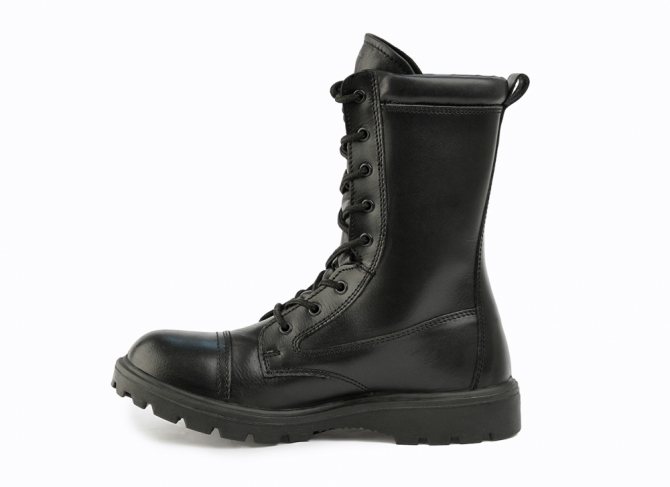
If you need ankle boots for fishing, hunting, walking in the forest and for other similar purposes, inexpensive options from Zenkis, Mc Allister or Mil-Tec will suit you. Such models last a long time with normal, infrequent use.
Do you travel often? Do you need ankle boots for hiking and backpacking trips? Do you need to choose an option for airsoft, paintball and similar purposes? Ideal options are Lytos, Max Fuchs, Original SWAT, Bates, some Mil-Tec options. For non-daily use, these brands will provide you with long service.
What are the best tactical combat boots for military and special forces?

Are you a professional military man? Do you need very reliable and durable boots for combat operations? Pay attention to: 5.11, HAIX, Belleville, Magnum. At the same time, you need to understand that these models are ideal specifically for serious military operations, for anti-terrorist operations; they are often used by special forces units, etc. Manufacturers promise that they will reliably serve for several years even with rough and daily use.
What are the best tactical military combat boots as a budget option?
If you are just a conscript and need combat boots for everyday use in normal conditions (for example, security, police, duty, training), feel free to choose the Mil-Tec brand, which produces good-quality budget options, but without compromising quality. They may not last as long as the famous boot brands, and they may not look as stylish as branded military boots, but they will get the job done. You will be pleased with the price/quality ratio of this company's shoes.
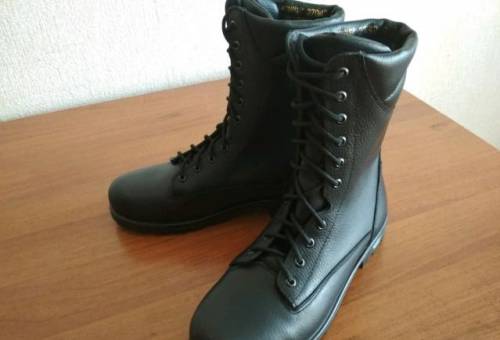
Buy ankle boots
Links to other sites
I suggest continuing the educational program and reading articles on the same topic from other resources. I find that it can be really useful to read alternative versions, this way you can better remember the most important points.
- Article - review on a site popular among professionals - risk.ru
- Translation of an article by American traveler Brandon Lampley, who passed through the whole of America “through and through”
- Review of the personal collection of shoes of a good traveler - Dmitry Kovinov
- A good review on the pages of LiveJournal: 21 manufacturers of hiking shoes
PS
This is a lot of text, but I hope this will help in choosing your faithful companions, and you will walk with them hundreds, or even thousands of kilometers through the most amazing places of our amazing planet! The more carefully you prepare for travel, the fewer things will distract you from true enjoyment. Have a comfortable hike, take care of your shoes and they will protect you!
Comments
- toptun777 16 June 2020, 21:07 0
Very informative! I am sure that after this article I will begin to take the selection of shoes much more seriously! Please recommend stores in the city of Ufa where you can choose good shoes.answer
- Robert Valeev 16 June 2020, 21:39 0
There is an article about stores in Ufa - Shoes are mainly in Trial-sport, in Planet-Sport and there are some in Active-style (Asolo Dolomite). Cheaper options can be found in Decathlon, they are not as reliable, but they are ok for simple hikes)
answer
Buy sportswear and shoes from trusted suppliers! link removed We have been ordering sports shoes and clothing from them for several years now and are very pleased with the price, speed of delivery and assortment! I recommend.
answer
Your article was stolen and the author was not indicated, here www.instagram.com/p/Bi2qh4sh1eU/
answer
Robert Valeev May 17, 2020, 10:37 am 0
Thank you very much for the tip, I’ll write to the thief, it’s a pity that people don’t appreciate other people’s work.
answer
The most important thing when hiking in the mountains is the right shoes! For a long time I was looking for information on shoes for hiking, but everywhere there was only water. However, these guys have everything clear and now I’m going to climb!
answer
